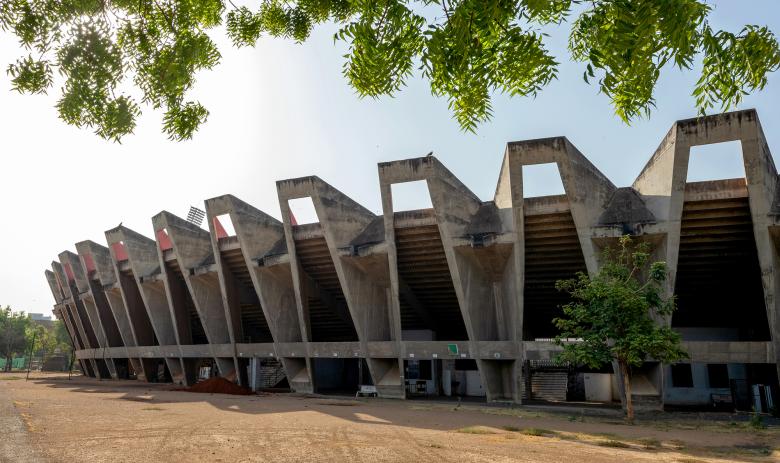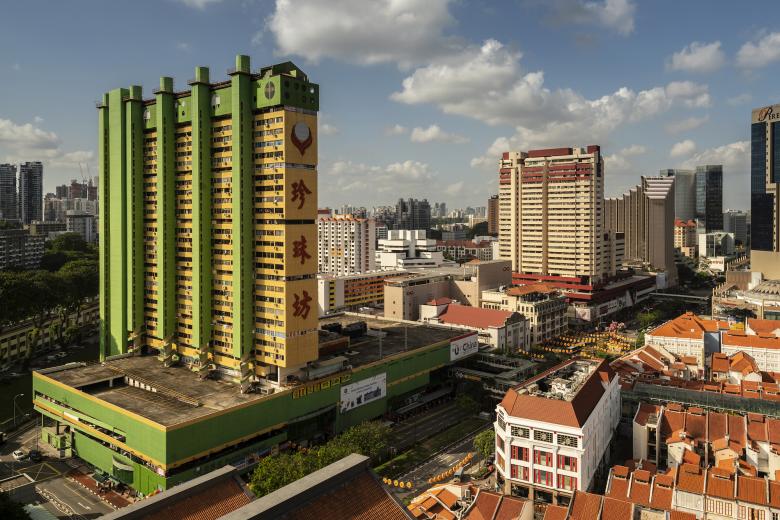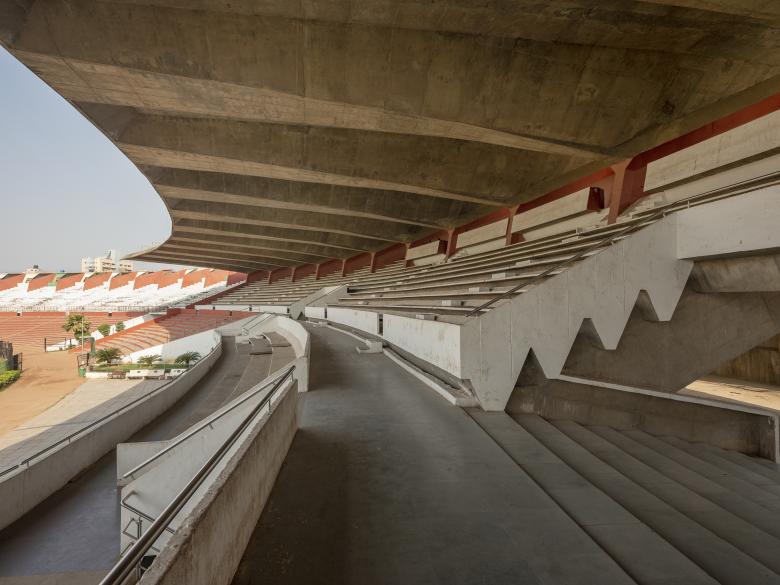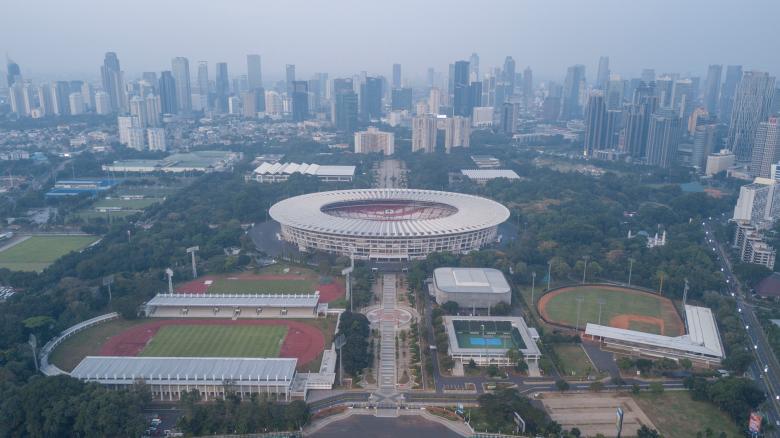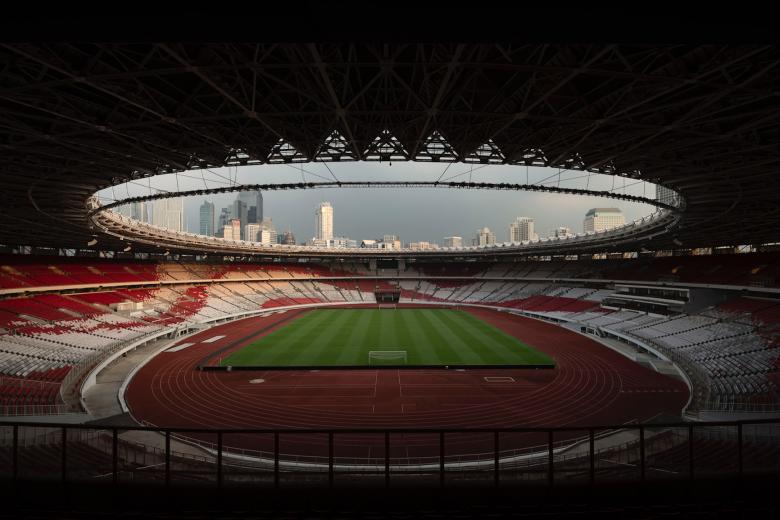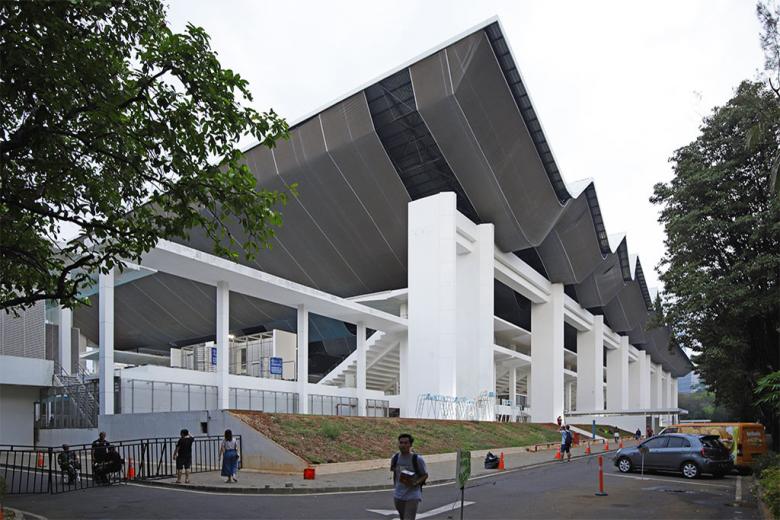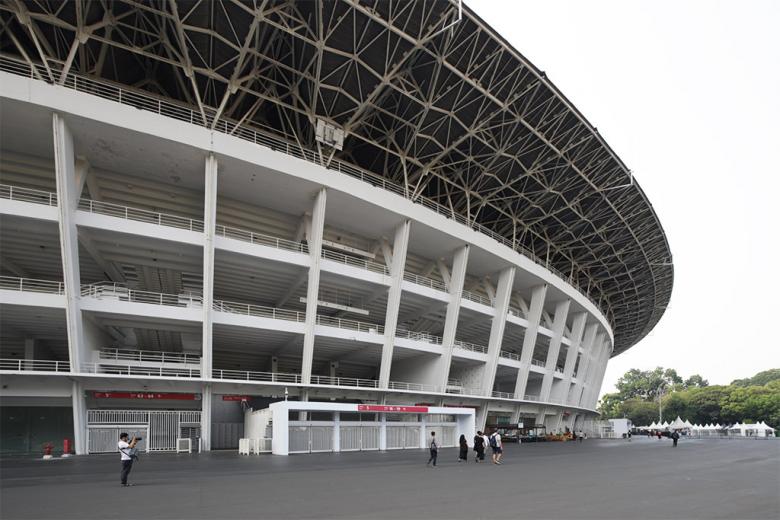Keeping the World Modern
Ulf Meyer
21. junho 2021
Sardar Vallabhbhai Patel Stadium in Ahmedabad, India. (Photo © Sanat Jhaveri & Co., courtesy of World Monuments Fund)
Contested Modernities consists of symposia, an exhibition, and a publication focused on postcolonial architecture in Southeast Asia as part of the long-term program Encounters with Southeast Asian Modernism. Ulf Meyer watched Contested Modernities’ second symposium, “The Present of Modernity,” that took place on June 11, filing this report.
“A collective sales fever” breaks out when real estate investors in Singapore find out that the plot ratio of a piece of land in the wealthy city-state is not fully used. When offering a nice amount of cash to inhabitants for moving out before their modernist housing block is torn down and replaced with a bigger, newer tower, most residents are happy to accept the deal, no matter how architecturally valuable the current building is. The video “Stop Architectural Deforestation” explains this cycle of a city consuming its own heritage.
The video was made by Ho Weng Hin — founding partner at Studio Lapis, lecturer at the National University of Singapore, chair of Docomomo Singapore, co-author of Our Modern Past: A Visual Survey of Singapore Architecture, 1920s–1970s, and Singapore’s most profound connoisseur of mid-century modernism — for Contested Modernities, the multi-format program that recently convened an online symposium focused on Singapore and Indonesia.
Even with its narrow geographical focus, the event elaborated issues of preservation and adaptive reuse that are relevant and pressing in all eleven Southeast Asian nations. After gaining independence last century, modernism often offered an aesthetic program of progress and prosperity for Southeast Asian nations and a means of emancipation from colonial powers. Local variations of modernism were created, based on local cultures and the tropical climate.
People’s Park in Singapore by DP/William Lim combines Corbusier’s Unité concept with a shopping mall in a “tower-on-podium” typology. (Photo: Darren Soh)
The rate at which modernist architecture in Singapore is being demolished is cause for concern. Often referred to as “ugly,” “run-down,” and “urban blight,” modern buildings are perceived superficially, but Ho wants to steer the conversation towards sustainability. An increased focus on preserving the grey or embodied energy in buildings may help the preservationists in their efforts. Ho hopes that the built heritage can be saved by moving the discussion away from subjective perceptions to the climate and environment.
Saving heritage actually equals saving the environment when Ho advocates for the preservation of iconic modern structures such as the People’s Park or the famous Golden Mile Complex (both designed by DP Architects/William Lim). The video compares knocking down large early modern buildings to “burning books” (culturally) and burning down a rain forest (ecologically), drastic phrases that express what is at stake in “keeping the world modern.”
Sardar Vallabhbhai Patel Stadium in Ahmedabad, India. (Photo © Sanat Jhaveri & Co., courtesy of World Monuments Fund)
The symposium was organized by the Berlin-based group Encounters with Southeast Asian Modernism. Kicking off the event, German architect Moritz Henning introduced conservation expert Antoine Wilmering from the Getty Foundation in Los Angeles. The Getty‘s Keeping It Modern initiative, which ran from 2014 to 2020, focused on the conservation of key modern buildings from the twentieth century. Since the program could not support the conservation of private buildings, public sports facilities were a typology in abundance. None of Keeping It Modern’s 90 grants that awarded well over $12 million, however, were located in Southeast Asia.
In his overview of the initiative, Wilmering shared his views on the challenges of preserving modernist buildings, including technical aspects. In many cases, their once novel building materials and structural systems have not performed well over time. Contemporary heritage professionals do not always have data on the nature and behavior of the materials and systems that were used in order to develop proper protocols for conservation. That is where the Getty program was most valuable: providing money to carry out that research.
A good example of this work is the refurbishment of the Sardar Vallabhbhai Patel Stadium in Ahmedabad, designed by India’s master architect Charles Correa and his civil engineer Mahendra Raj. The stadium represents the progressive ideals of India’s post-independence period in the 1960s. It was built to host cricket matches, but a bigger stadium was constructed next door in 1982. Because the earlier stadium suffered physical degradation, it was included on the World Monument Fund’s (WMF) 2020 World Monuments Watch. The WMF encouraged a conservation management plan —exactly what the Getty supported with its 2020 grant.
The area around GBK stadium is one of Jakarta’s few larger public parks. (Photo © Davy Linggar)
Jakarta’s d-associates presented a good example of sensitive refurbishment: the renovation of the Gelora Bung Karno (GBK) Stadium in Jakarta, designed by architect Frederich Silaban and built in 1962. Partially funded by the Soviet Union, the stadium is a valuable precedent for the preservation and adaptive reuse of modern architecture in the tropics. D-associates managed to turn GBK “from a sports complex into a public park,” as they call it. The cantilevering roofs were extended and benches on the bleachers were replaced by individual plastic seats in the national colors of Indonesia. The exposed concrete surfaces were refreshed and five ramps introduced for accessibility.
The GBK stadium in Jakarta was built with the help of the Soviet Union (Phoot © Davy Linggar)
The refurbishment of the GBK — and more importantly the re-purposing of former wasteland between the “white elephants” of the giant stadia into an attractive public urban tropical park — is just one example of an adaptation of a 1960s urban design to new uses. It evaluates mid-century modern architecture and urban design beyond mere aesthetics — at a time when rapid urbanization and rising property values threaten the preservation of Southeast Asia’s masterpieces of modern architecture.
GBK's sports facilities were upgraded for the Asian Games of 2018. (Photo © Moritz Henning)
“The Present of Modernity” online symposium shed a spotlight on the large region, focusing on the big issue of preserving post-war modernist architecture and urban design in Southeast Asia. The conference is part of a larger series of events that kicked off in April with a symposium and will see two more symposia and an exhibition in the fall. The last, to take place at the Haus der Statistik (House of Statistics) in Berlin, will examine regional architecture from the 1950s to the 1970s with contributions from four Southeast Asian cities: Phnom Penh, Jakarta, Yangon, and Singapore. A recent issue of Arch+ magazine (in German) also extends the debate.
